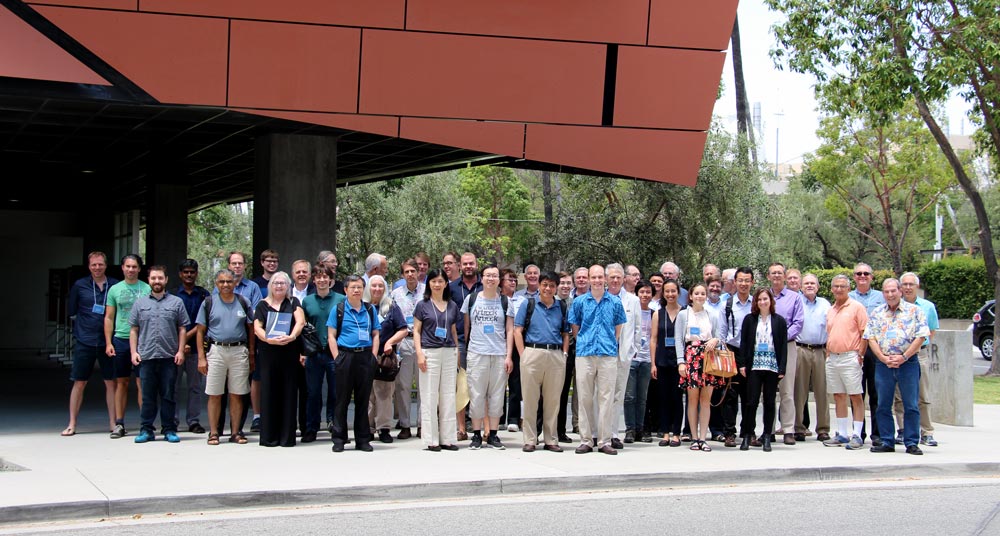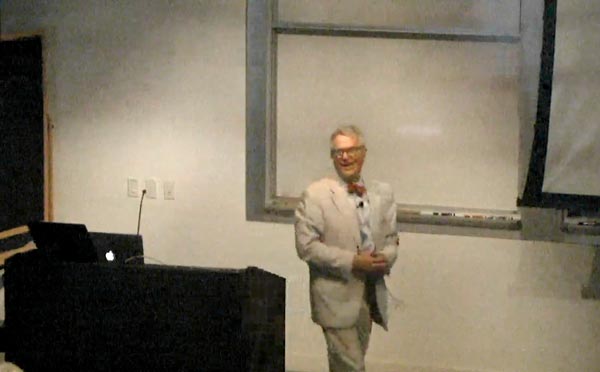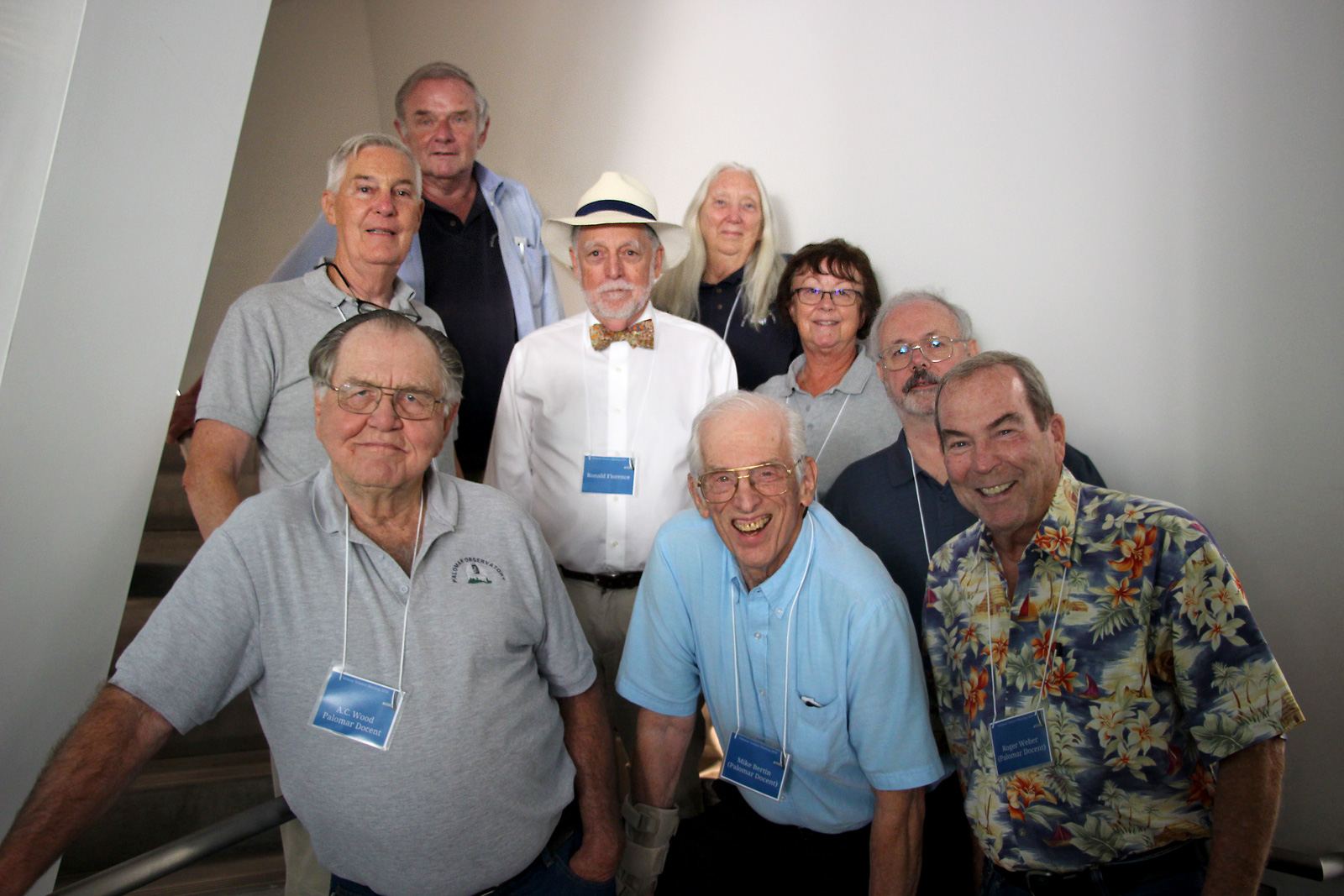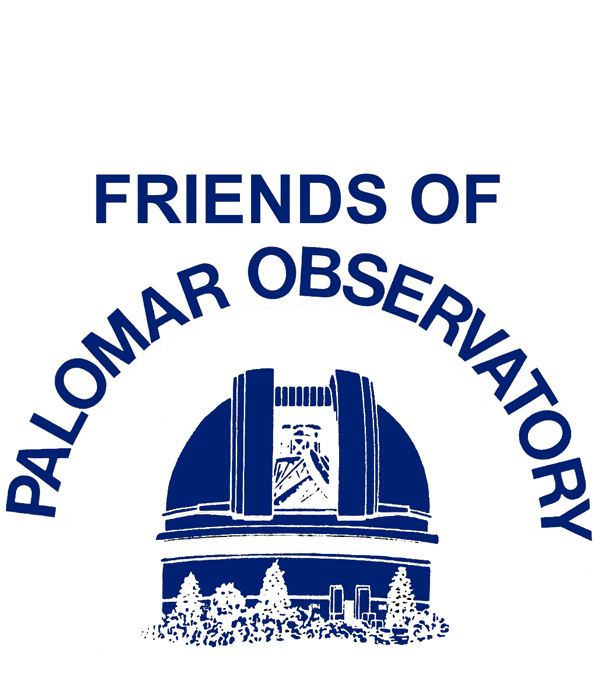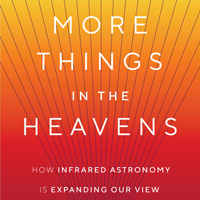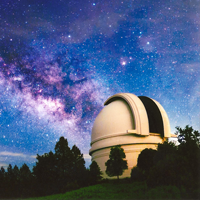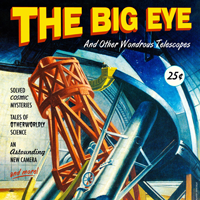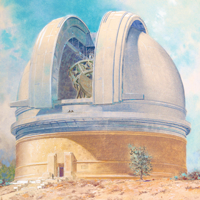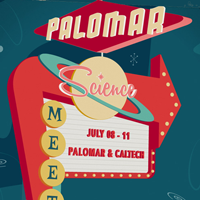Friends of Palomar Observatory Website
Upcoming Event

The Newsletter of the Friends of Palomar Observatory, Vol. 13 No. 2 – August 2018
Accelerating Discovery:
The 2018 Palomar Science Meeting
By Steve Flanders
In his keynote address to an audience in Caltech's Hameetman Auditorium, Robert Kirshner of the Gordon and Betty Moore Foundation made reference to something that Edwin Hubble had written in 1936. Having worked closely with Fritz Zwicky, Richard Tolman and other Caltech scientists, Hubble suggested that in his experience such collaborative efforts “engendered a common atmosphere in which ideas develop.”
The 2018 Palomar Science Meeting (PSM2018) was called to promote Hubble's “common atmosphere” of ideas at Caltech by providing a forum for all Palomar astronomers and constituencies to share and discuss the science and engineering results they have derived from work done at the Observatory. Caltech has held such professional conferences periodically for many years.
But, in contrast to previous meetings, the 2018 event also had a second, more general purpose. This gathering was planned as a celebration of Palomar's 70 years of discovery, an event to commemorate the 70th anniversary of the dedication of the Hale Telescope, to honor George Ellery Hale on the 150th anniversary of his birth and to mark the dedication of the Zwicky Transient Facility (ZTF).
PSM2018 extended across four days in July. Through eight sessions, 38 speakers described some of the many contributions that have been made and are being made at Palomar Observatory to the disciplines of astronomy and astrophysics. Their 38 presentations covered a variety of topics, from discussions of the histories of the Hale and Samuel Oschin telescopes in Session 1 to descriptions in Session 8 of the engineering innovations that have increased the efficiency of the cameras and other detectors used on the Palomar telescopes. Many of the presentation materials—abstracts, PowerPoint slides, and videos—are available on the PSM2018 website at the Event Program page.
All of the people who spoke were either researchers who have taken data at Palomar or engineers who are developing instruments for Palomar. While associates of Caltech and JPL were most numerous, the 38 contributors represented an array of academic research institutions including Yale University, the National Astronomical Observatories of China, and the American Museum of Natural History. Typically, the speakers presented their work to their academic colleagues, giving specialized, often technical descriptions of their methods and results.
Video composed of surviving original audio and footage, stock Palomar footage, and photographs taken during the June 3, 1948 ceremony. (Caltech Optical Observatories)
Even so, quite a few of those who addressed the attendees approached their subjects in more general, sometimes historical terms. For example, Rebecca Oppenheimer, curator in the department of astrophysics at the American Museum of Natural History, was responsible for the development of an exoplanet imaging system. Offering the audience a narrative that “contains no science,” she characterized her talk in Session 5 as “musings” on Project 1640, its results and future applications. In her conclusion, Oppenheimer paid her respects to Palomar Observatory's unique role in advancing science through its support for the development of devices of “radical instrumentation.”
With these varying levels and approaches, the 38 presenters addressed a range of subjects. Each of the eight sessions had its own theme and included a collection of talks pertinent to that theme. In summary:
Session 1: Celebration at Palomar Observatory, Sunday 8 July
This session opened with a video of the Hale Telescope Dedication announcement at Palomar from June 3, 1948. Sterl Phinney, Professor of Theoretical Astrophysics at Caltech, and George Djorgovsky, Professor of Astronomy, spoke on the histories and legacies of the Hale and Samuel Oschin telescopes, respectively. Palomar docent, Mike Bertin provided a commemorative biographical sketch of George Ellery Hale. During the afternoon, attendees were given tours of the two telescopes and of the science display in the Museum.
Session 2: Planets at Palomar, Monday 9 July, Morning
Reconvening on the Caltech campus, Session 2 was concerned with planets orbiting distant stars and with asteroids in our own Solar System. Four of the five speakers described the search for exoplanets, the confirmation and characterization of exoplanets and the direct imaging of exoplanets. Joe Masiero from JPL spoke of his studies of near-Earth asteroids.
Session 3: Multi-Messenger Astronomy, Monday 9 July, Morning

“Open Late” promotional poster. The four PSM promotional posters, as well as the new 70th anniversary edition of the Palomar Tradition booklet are now available at the Palomar Gift Shop. (Palomar/Caltech/Annie Mejía)
Not long ago, electromagnetic radiation provided our primary window on the Universe. Now we are able to detect gravitational waves and this allows us to observe certain events using two distinct but complementary channels. And even within the electromagnetic spectrum, we are able to acquire information from multiple paths. Jacob Jencson, a Caltech graduate student, described how supernovae may be found by combining infrared observations from the Spitzer space telescope with near-infrared and visual spectroscopy on the Hale Telescope. During this session, Rick Burruss, superintendent at Palomar, recognized the efforts, professionalism and dedication of the members of the Observatory staff.
Session 4: The (More) Distant Universe, Monday 9 July, Afternoon
All four presenters in this session were concerned with the key attributes of quasars: mass, accretion rates, growth and distribution patterns among others. Even so, each speaker had a particular area of concentration. To cite two examples, Xue-Bing Wu of Peking University discussed distant high redshift quasars while Philip Appleton from Caltech's Infrared Processing and Analysis Center (IPAC) focused upon a class of nearby quasars that show evidence of having been disturbed by shocks and turbulence.
Session 5: Palomar Recollections, Monday 9 July, Afternoon
Four members of the Palomar community offered more general thoughts and recollections. Judith Cohen, Page Professor of Astronomy, Emeritus, began this session with “a tribute to the visionary people who built and used [the] Palomar facilities.” Tom Soifer, Brown Professor of Physics, discussed the development of infrared astronomy at Palomar. Michel Werner, JPL's project scientist for the Spitzer Space Telescope, reviewed “a program of millimeter wavelength astronomy” that began in 1972 and is now “largely forgotten.” Session 5 concluded with Rebecca Oppenheimer's discussion of Palomar's role in the development of “radical instrumentation.” Also, Andy Boden, Deputy Director of Caltech Optical Observatories, gave a “shout out” of appreciation to the volunteer docents of Palomar Observatory.
Session 6: Transient Astronomy, Tuesday 10 July, Morning
First among this session's 9 presenters, Shri Kulkarni, Caltech's Hale Professor of Astronomy and Planetary Science, described the “arc” of development and innovation that began with the Palomar Transient Factory (PTF) and grew into the Zwicky Transient Facility (ZTF). With a “high rate of discovery” and a “widened ... scope of investigations,” ZTF, according to Kulkarni, constitutes “the stepping stone for the national flagship project, the Large Synoptic Survey Telescope.” With this beginning, much of the remainder of the session concerned related topics: ZTF science projects; ZTF engineering; the ZTF public survey; the ZTF bright supernova survey; and ZTF machine learning among others.
Session 7: Commemoration (Public Event), Tuesday 10 July, Afternoon
As described by Andy Boden in his companion article, this public commemoration and dedication session served as the focus of the meeting. Indeed, Robert Kirshner made “Accelerating Discovery” the central theme of his address. It is his assertion that the people of the Palomar community are not merely advancing the boundaries of science but rather are developing new technologies, attracting imaginative scientists, and creating new collaborations to such an extent that they are driving the entire scientific enterprise forward at increasing rates of speed. The moment was made compelling by the fact that the ZTF dedication immediately followed Kirshner's talk and ZTF has been described by Shri Kulkarni as representing “astronomy on an industrial scale.” In this way, the ZTF program may be understood as a concrete manifestation of Kirshner's call to action.
Session 8: Innovations, Wednesday 11 July, Morning
PSM2018 concluded on Wednesday with eight presentations describing many of the technology programs that are of such importance to Palomar's continued leadership. A number of speakers emphasized the central role that Palomar plays in the development of the advanced detectors used on many of the world's largest telescopes. Michael Ressler from JPL talked about how a simple infrared detector starting at Palomar led to the MIRI instrument that will go into space on the James Webb Space Telescope. Similarly, Caltech's Matt Matuszewski described the manner in which a seeing limited integral field imager on the Hale Telescope, the Cosmic Web Imager, served as the basis for the Keck Cosmic Web Imager.
Taken all together, clearly the Palomar community is a remarkably large and varied assembly of talented and deeply committed people.
Commemoration
By Andy Boden
The focal point of Palomar Science Meeting 2018 was the keynote session titled “Commemoration” Tuesday afternoon 10 July. This session was held in Hameetman Auditorium at the Cahill Center for Astronomy and Astrophysics. The keynote session program celebrated the Hale Telescope Dedication 70th Anniversary (03 June 1948), the Zwicky Transient Facility Dedication, and included recognition of members of the Zwicky and Hale families in attendance.
Author Ronald Florence began the session by presenting a talk titled “Creating ‘The Perfect Machine’”. Dr. Florence’s remarks wove a joint narrative of the Hale Telescope creation story, and of his personal five year journey of research and writing his definitive book celebrating the Hale “The Perfect Machine”. Dr. Florence’s love of his subject and the cast of characters shone through clearly, and many Palomar enthusiasts (myself included) had the opportunity to visit privately with Mr. Florence both before and after his remarks.
Next to speak was Prof. Robert Kirshner, Chief Program Officer for Science at the Gordon and Betty Moore Foundation, Clowes Research Professor of Science, Harvard University, and a distinguished alumni of Caltech. Prof. Kirshner’s remarks, titled “Accelerating Discovery” drew upon his personal history at Palomar Observatory, and described how work at Palomar—particularly by Fritz Zwicky, and on the 18” and Samuel Oschin Telescopes—set the stage for modern observational cosmology. Prof. Kirshner’s own involvement in this subject has led to his selection as the 2015 Wolf Prize for Physics recipient, as well as his central role in work recognized with the 2011 Nobel Prize in Physics.
Speaking on behalf of the new Zwicky Transient Facility was its Principal Investigator Shri Kulkarni, the George Ellery Hale Professor of Astronomy and Planetary Science at Caltech. ZTF is a broad collaboration with major support from an international consortium of institutions and the US National Science Foundation (NSF). Shri described ZTF scientific objectives, and traced ZTF origins back to Zwicky’s visionary and pioneering work on broad reconnaissance at Palomar. In naming ZTF in honor of Fritz Zwicky Shri and Caltech seek to recognize Zwicky’s enduring scientific legacy.
In the final remarks of the session, daughter Barbarina Zwicky spoke on behalf of the Zwicky family—expressing gratitude for the recognition of her father’s work, and sharing remembrances of a devoted father. All in attendance appreciated the opportunity to hear the perspective of someone who knew Zwicky as a person and not just a scientific icon. The afternoon closed with a reception for all attendees.
COO Directorship Transition
By Andy Boden
Many of you know that Caltech Optical Observatories (COO) is the administrative home for Palomar Observatory on the Caltech campus. What you may not yet know is that, as of 01 May 2018, COO is under new management: longtime Director Prof. Shri Kulkarni has passed the COO Director’s duties to Prof. Jonas Zmuidzinas. Shri served as COO Director for 12 years (2006 – 2018), and guided COO and Palomar to many important successes. Principal among them is the highly successful Palomar Transient Factory (PTF) arc of projects—culminating with the recent commissioning and dedication of the Zwicky Transient Facility (ZTF). Shri has stepped down as COO Director to focus on ZTF and related projects full time—and as such he will remain a prominent member of the Observatory community. I know I speak for all of us when I express our deep appreciation for Shri’s long and distinguished leadership and service to Palomar Observatory and our community.
Jonas is the Merle Kingsley Professor of Physics at Caltech, and comes to the COO Directorship with an extensive background in instrumentation development, experimental physics, and scientific leadership. In addition to his Caltech academic duties, Jonas has served as JPL’s Chief Technologist and as the Director of the JPL Microdevices Laboratory; CCAT Project Scientist; and on instrument teams for Hershel, SOFIA, and CSO. Jonas and Shri have been working closely together with Observatory management and our Palomar partner representatives to effect a smooth leadership transition. This is an exciting time at Palomar Observatory: with new instruments arriving, being commissioned, and in development on all our telescopes; recent commitments for continued partnership among all our major partners; and exciting scientific opportunities ahead in the coming era of transient astronomy, GAIA, and LSST. Under Jonas’ leadership the Observatory management team looks forward to working with our community in realizing the Palomar’s potential in the coming decade.
Upcoming Event
On Saturday, 15 September, we’re holding a star party at the Outreach Center. I’ve titled this event as “Four Bright Planets and the Moon.”
It will start at 6:00p. Everyone is invited to contribute to the desert potluck.
The event will start with a presentation titled “Palomar Observatory in the Popular Culture” by docent Mike Bertin. Sunset is at 7:00p and we’ll get out the telescopes soon after. FOPO members may bring telescopes and binoculars if they wish.
- Steve Flanders
Questions? We've answered many common visiting, media, and academic questions in our public FAQ page.
Please share your feedback on this page at the
COO Feedback portal.
Big Eye 13-2
Last updated: 19 August 2018 AFB/SBF/ACM
